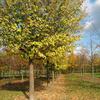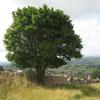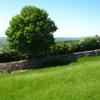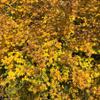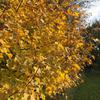Great choice! We're adding your items to the basket and working out what else you might need to plant it.
Field Maple Acer Campestre
Example photos only. Size, stem height and habit may vary.
Please contact us for photos of current stock.
Select plant type
Quantity
British Grown – The British Grown logo denotes plants and trees that have been both propagated and grown in the UK. Read more
Product Description
ACER CAMPESTRE - Field Maple
Characteristics
Field maple is a medium-sized native tree with a bushy, rounded head which can grow 15m (50ft) tall in good conditions though often stays smaller. The small leaves are of typical maple shape, though more rounded than some in the Acer family.
The tree's autumn colour is a striking butter-yellow, and is one of the best from a species native to the British Isles. When young, the bark has a curious cork-like appearance, though as the tree matures this disappears. Inconspicuous spring flowers develop into winged seedpods, which are tinged pink at first.
Where to grow
Field Maple will grow on most sites though it is especially happy on shallow soil over limestone and for this reason is very at home in southern England where it is commonly found at field edges and as a standard tree.
It also makes a wonderful hedging plant and is nearly as common in native countryside hedges as hawthorn or blackthorn. The reason for this is that it will take fairly severe cutting. It can also be laid, helping to create a strong stock-proof hedge.
Very young trees will grow in shade, but plenty of light is required by older trees.
Did you know?
Field maple shot to fame in 2011 when it was chosen as one of the trees used to line the aisle of Westminster Abbey at the wedding of Kate Middleton and Prince William. "The trees are field maples, which is a very English native tree and the field maples symbolise reserve and humility,” said Shane Connolly, the artistic director of flowers for the ceremony.
Features
-
Mature Height
- Medium - 10-15 metres
-
Spread
- 5-10 metres
-
Shape / Habit
- Shrub Multi-Stem
-
Growth Rate
- Medium
-
Soil Type
- Clay
- Chalk/Limestone
- Light sandy
-
Sun Levels
- Full sun
- Partial shade
-
Difficulty / Hard to Grow
- Easy
-
Evergreen / Deciduous
- Deciduous
-
Autumn Colour
- Yellow
-
Leaf Colour
- Green
-
Foliage
- Small leaves
-
Flowering Month
- April
- May
-
Uses
- Screening
- Parkland Tree
- Garden Tree
- Small garden Tree
- City/Urban Sites
- Country/Farmland
- Encourages wildlife
- Wind break
-
Hedging
- Native Hedge
-
Native / Naturalised
- Native
-
Season
- Autumn
- Summer
-
Other Features
- Good at altitude
Aftercare
Pruning Acer Campestre
Acer Campestre can be formatively pruned to create a clear stemmed tree, but once established should only require pruning to remove damaged or diseased stems. If planting as a hedgerow, only cut the laterals back until the hedge is at the desired height, then trim annually to maintain. An established Acer Campestre hedgerow can take hard cutting, and can also be laid.
What time of year should I prune? Prune in winter (November to January) when the plant is dormant. Acers will bleed sap if pruned while in growth, which is usually not harmful but can be unsightly.
For the continued healthy growth of your trees, shrubs or hedging it is vital that you follow the advice below.
Watering
The main reason that plants die within 12 months of having been planted is lack of water. It is essential throughout the spring and summer, to give a heavy enough watering to enable the water to penetrate right down to the deepest root level of the tree. In hot dry spells give the equivalent of 2 bucketfuls every three days.
Weed Control
One of the most common causes of lack of water is competition from grass. When trees are first establishing, the grass roots would be at the same level as the tree roots and are far more efficient at taking up water and thus choke the tree. It is vital that for at least 3 years after planting your tree or hedge has a circle or strip one metre wide completely free of grass.
- Mulch mats are an effective way to stop grass and weeds, although they will require a careful eye to make sure they continue to work. After clearing the ground around the tree, firmly fit the mat by tucking the edges into the soil and put a thick layer of bark mulch on top of this. Be careful not to allow the woodchip to touch the stem as it can cause rot.
- Weed killer is very effective, however it is harmful to the environment. Organic weed killers usually do not kill roots. Weed killer needs to be applied each year for the first 3 years, preferably when the tree is dormant, or just once before applying a mulch mat.
- Mowing or strimming is NOT an answer to the problem. Each time you mow, the grass will grow back more vigorously and strimming invariably leads to lacerated trunks.
Staking
If trees are not correctly secured they will rock in the planting pit. Roots not firmly in contact with the soil are unable to take up moisture and nutrients, resulting in die back or death of the tree. Check, particularly after windy weather, that stakes are still solidly in the ground keeping the base of the trunk firm. The purpose of the stakes is to anchor the roots. Flexing in the wind, higher up the trunk, is not necessarily a problem if the roots are firm.
Bellow is list of the correct system to use to secure your trees.
- 40/60, 60/80, 80/100 whips - Unless rabbit/deer problem no need to stake.
- 100/125, 125/150 1.2m Cane and Easi tie.
- 150/175 1.2m square stake and a buckle tie and spacer.
- 175/250, 6/8, 8/10 15L 1.65 Tree stake and a buckle tie and spacer.
- All larger trees. 2 x 1.65 Tree stake and cross rail with 38mm cushion spacer and 1m of 38mm strapping.
Ties
Always use our recommended tree ties or strapping. These are designed and manufactured with the correct amount of give to hold the tree firm without strangling it. They should be checked at the end of each growing season for adjustment as the trunk thickens. Non proprietary materials such as baler twine will cut into the bark and should not be used.
Protection from Animal Damage
Rabbits, deer, sheep, cattle and horses can all potentially damage trees. Ask us for advice on the most appropriate guards for your trees or hedge. Squirrels are also a terrible pest when trees get to about 20ft tall but there is no protection available.
Are the delivery costs the same no matter how many plants I order?
Yes the delivery costs stay the same no matter how many plants you have on your order. They are worked out based on your distance from our nursery and can be found here.







